I wasn’t sure going into this how much I would comprehend. I understand the reaction of Saponification on a very basic level. I was familiar with Kevin Dunn as he is of some “fame” in the soapmaking world, so of course I wanted to hear him speak.
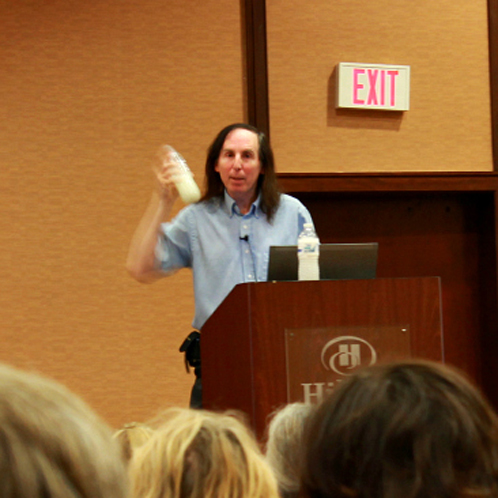
I was immediately at ease with Mr. Dunn’s kind and humorous nature; he is clearly comfortable in front of a crowd and his humor is delightfully refreshing. I highly recommend going to his session if you are thinking of attending a Handcrafted Soap and Cosmetic Guild Conference – he is so delightful and you’re sure to understand at least parts of his lecture.
For the first part of the presentation he spoke about:
- Lipophilic – oil/fat loving
- Hydrophilic – water loving
- Amphiphilic – loving both oil and water
This involved a colorful illustration of the relationship between oil and water utilizing the analogy of “nerds and cheerleaders” – you can just imagine, right?
Soon after the “nerd and cheerleader” analogy we performed a clever experiment with water bottles that were filled halfway with water and soap.
This was an illustration of Fatty Acid Equilibrium. First we shook the bottle up to agitate the solution causing bubbles to form. By adding the vinegar (an acid) the bubbles disappeared and there was a notable color change in the solution as well (to a slight yellow). By adding ammonia into the solution we raised the alkalinity causing the bubbles to reappear.
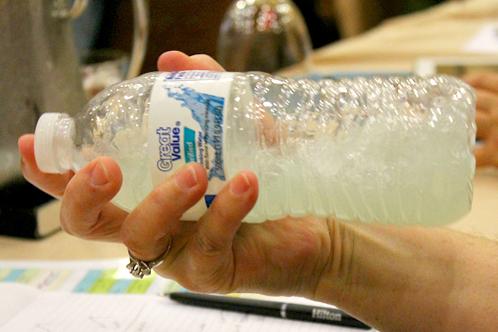
Shaking up the bottle
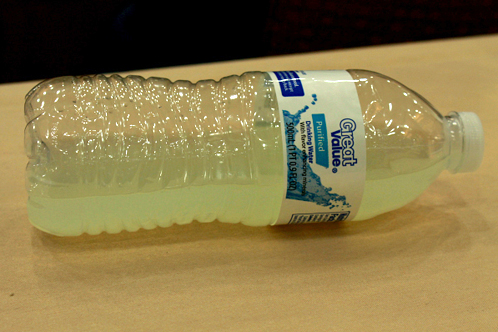
After we added vinegar
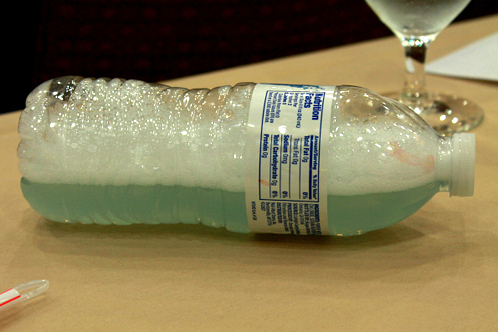
After we added ammonia
This experiment soon led us into talk of triacylglycerol, diacyglycerol, monoacylglycerol (otherwise known as tags, dags, and mags) and the stoichiometric hypothesis (huh?) – and this is where things went gray and fuzzy for me. I was lost in the mire of fatty acids, and just when I thought all was hopeless, there was a faint light at the end of the tunnel when the conversation took a turn into more familiar terms of lye discount and superfat.
We all know that a lye discount is used when we don’t want excess lye in our finished soap and the term “superfat” means to add excess fat. In conclusion and in plain non chemist terms Mr. Dunn explained…..wait for it….that whether you use a lye discount or superfat the results are the same, so for those of you who are waiting until that crucial moment to add your superfat to your soap…it really only creates more stress and work. Begin with a lye discount and you’ll never have to worry about that critical moment for adding your superfat again.
Thanks, Michele! Our other conference guest blogger, Jean of SoapArt, also attended this class. Get her take on it here!

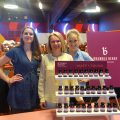
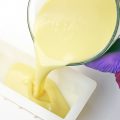
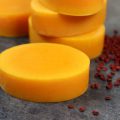
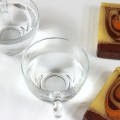
It was a great session,Dr.Dunn has lots of fun in front of a crowd.
Good morning, Michele!
Thank you so much for attending the conference! We were so excited to read your recap of Dr. Dunn’s class and were glad that you enjoyed it so much. =)
-Becky with Bramble Berry
Great recap of the session, Michele! It’s fun reliving the chemistry lesson.
Hi Jean!
We loved both yours and Michele’s recap of Kevin Dunn’s chemistry lesson and I know I learned more about soap then I did before (so exciting)! =)
-Becky with Bramble Berry